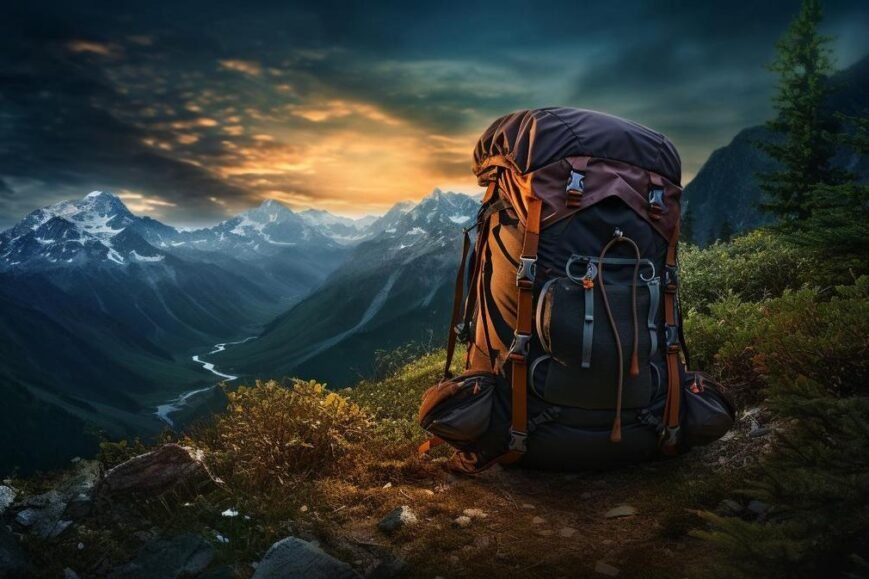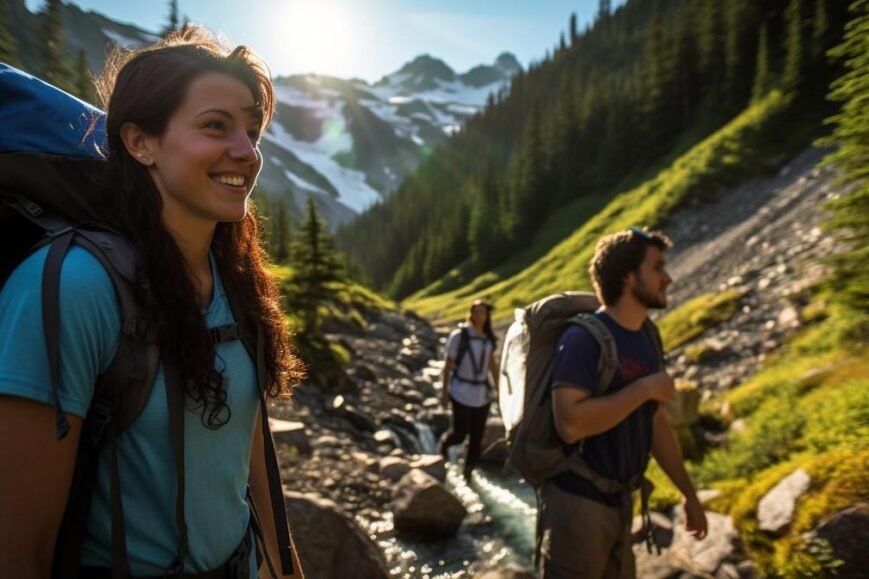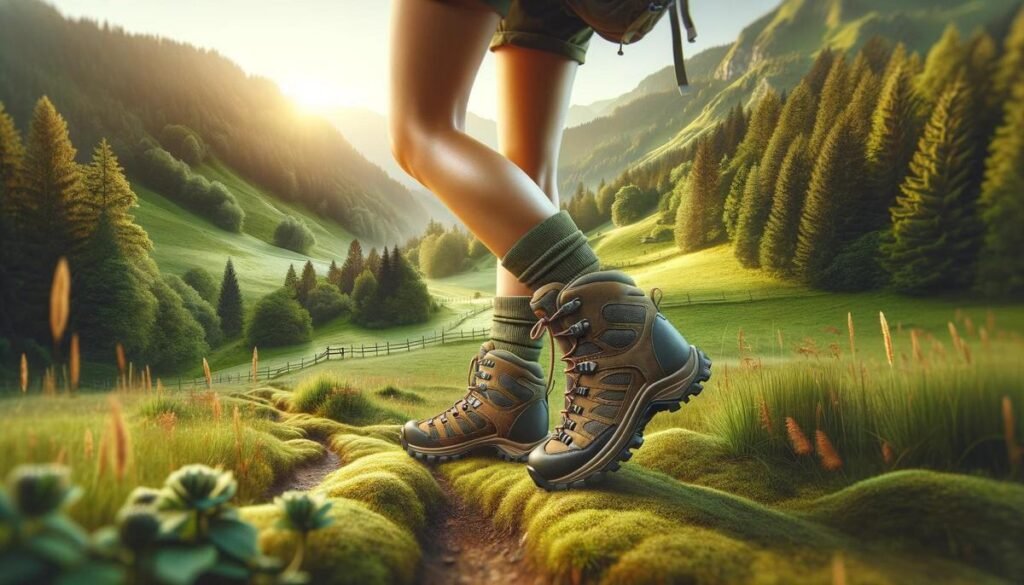- For an overnight hike, pack safety gear, navigation tools, appropriate clothing, a lightweight shelter, and a first-aid kit.
- Essential equipment includes a comfortable, durable backpack and a tent suitable for the terrain and weather.
- Night hiking requires proficiency with maps, compasses, and GPS, and awareness of local wildlife, using bear spray and food storage techniques if necessary.
- Food and water management involves packing energy-dense foods, using water purifiers, and carrying lightweight cooking supplies.
- Research local trails for unique experiences that match your skill level and desired scenery.
- New hikers should build physical and mental preparation, understand Leave No Trace principles, and plan with safety and etiquette in mind.
- Minimize environmental impact by using existing campsites, handling waste properly, and respecting wildlife.
- Carry a headlamp, emergency shelter, and signaling device for safety after dark, and familiarize yourself with the trail in daylight.
- Stay hydrated with a suitable water system, and maintain energy with balanced, lightweight meals and snacks.
- Prepare physically with endurance exercises, stretching, and proper nutrition; post-hike, eat nutrient-rich foods, and practice relaxation for recovery.
Preparing for an overnight hike? It’s exciting but don’t step out the door just yet! A solid plan means more fun and less trouble. You’ll need the right gear for safe trekking and good sleep under the stars. I’ll show you how to pack smart and choose the best shelter, so you’re ready when the trail calls. Ready to gear up and get on the trails? Keep reading to make your next adventure worry-free and unforgettable.
What Should Be on My Overnight Hike Preparation Checklist?
How do I plan an overnight hiking trip? First, list all you need. This should include:
- Safety gear and tools for finding your way
- Clothes and shoes that fit the hike
- Food and water to keep you going
For your night’s rest, what should you sleep in on an overnight hike? Choose from a tent, hammock, or bivy sack. Think about what fits the place and how heavy it is.
Always care for where you hike. Bring soap that won’t harm nature. Pack out all your trash.
Don’t forget a first-aid kit for accidents or sudden illness. Your safety must come first.
Think about where you are going. The trail or area may need special gear. Always check the local weather and trail info before your trip. This will help you stay safe.
Pack smart for one-night hikes. Your back will thank you if your load is light. But make sure you have all you need.
Remember, you share the woods with wildlife. Plan how to keep food safe and what to do if you see animals.
Checklists help you not to miss anything important for your adventure. Happy hiking!
How Do I Choose the Best Backpack and Tent for My Overnight Trails?
Overnight hiking trips need good gear. Your backpack and tent matter most. What’s called backpacking or trekking is not just about lacing up boots and hitting the trail. Planning is key. The question is: How do I plan an overnight hiking trip? Start by picking the right backpack. It should hold 3 to 7 days’ worth of stuff. Comfort is king. Look for padded straps and a hip belt. It should hug your back.
Now, tents. Choose based on where you sleep. For night hiking, the tent should match the weather and land. Think about space and weight. Roomier tents are bigger to carry. A heavy tent can tire you out fast.
Your backpack and tent should last. No one wants a broken strap or ripped tent. Get stuff that can take a beating. Do this, and you’re on your way to a great overnight hike.
What Are the Best Practices for Trail Navigation and Wildlife Safety on Overnight Hikes?
Is it smart to hike at night? Yes, but only with the right gear and know-how. When daylight fades, trails look different. You need a clear plan and tools to find your way. Pack a map, compass, and GPS for night treks. Learn to use these before your hike.
Animals are more active at night. Know what lives in your hiking area. Understand their habits to stay safe. Make noise while you hike to avoid startling wildlife. Carry bear spray if you’re in bear country. If you see an animal, stay calm and back away slowly. Never feed wildlife.
To keep animals away from camp, store food in bear-proof containers. Hang your food in a tree if you can. Pick a sleeping spot away from natural animal paths. Knowing how to navigate and respect wildlife ensures a safe and fun night on the trails.
How Should I Manage Food, Water, and Cooking on an Overnight Hike?
When you plan an overnight hiking trip, start by planning your meals. Choose foods that provide a lot of energy but don’t weigh much. Think of nuts, energy bars, and dried fruits. These are overnight hiking food essentials. Pack food that you can cook quickly. Instant oatmeal or soup mixes are good.
You also need water on your hike. Sometimes you find water on the trail. But you must make it safe to drink. Boil water or use a water filter or purification tablets. This is water purification on overnight hikes.
Bring must-have cooking gear. Take a small stove and fuel to cook or boil water. Your gear should be light so it’s easy to carry. Include a pot, a spoon, and maybe a small cup.
You need to store your food and water well. Use tight-seal containers so animals can’t get in. Keep everything dry and away from your tent to stay safe from wildlife.
Every hike needs a plan for meals, water, and cooking. With good planning, your hike is more fun and no stress!
Where Can I Find Unique and Memorable Overnight Hike Locations?
Overnight hike near me? Best places for overnight hikes near me. Explore nearby backpacking trails.
Finding a great overnight hike starts with some research. Look at maps, ask friends, and check online communities. They help a lot.
Famous trails are known for good reasons, like amazing views. They can offer the best overnight experiences you could ask for.
Search for trails that fit your skill level too. Some are just right for those new to hiking. Others will give hikers a tough challenge. Remember to look for variety in your area.
When you choose a trail, think about the scenery it offers and its length. Consider how tough the hike is and what others say about it. The right trail makes your adventure much better.
What Key Tips Should First-Time Overnight Hikers Know?
Preparing mentally and physically for your first overnight hike
Begin your hike prep with body and mind. Work out to build muscles for those hills. Hikes can be tough, so ready your mind too. Think of this as your fun challenge!
Essential knowledge about trail etiquette and Leave No Trace principles
Know the rules of the trail and stick to them. Respect nature and keep trails clean so others can also enjoy.
Building a support system: Going solo vs. finding a group
Plan to hike alone? Tell someone your plan. Better yet, join a hiking group. It’s safer and more fun.
Identifying and avoiding common novice mistakes
Pack light but bring what you need. Always check your gear before you hike. Learn these tricks to avoid mistakes that can ruin your trip.
How Can I Ensure My Overnight Hike Has Minimal Environmental Impact?
When you plan an overnight hiking trip, think green. Use Leave No Trace principles to keep nature wild. These principles tell us to hike and camp without hurting the land. They help us enjoy nature without leaving a mark.
So how do we apply Leave No Trace on overnight hikes? First, plan to visit places in small groups. This lowers your mark on the land. Pick a campsite that’s already been used. It helps to keep new areas untouched. When you pick a spot, make sure it’s durable. This means areas with rock, gravel, or dry grass.
What about handling waste? Always pack a small shovel. Dig a hole 6 to 8 inches deep for human waste, far from water, trails, and campsites. Cover and disguise the hole when you’re done. Pack out toilet paper and hygiene products to keep the land clean.
Remember, waste also means food scraps. Never leave food waste behind. Animals might get sick eating it, or it can harm the plants. Store food tight so animals can’t get in. This stops them from finding human food.
To care for wildlife, watch animals from a distance. If you see wildlife, keep calm and move slowly. This keeps you and them safe. Don’t follow or feed them because this can harm their health and change their natural actions.
Leave plants, rocks, and other natural things as you find them. When you follow these tips, you help keep nature as it is. This means everyone can enjoy it for years to come.
What Are the Essential Safety Measures for Hiking After Dark?
Is it smart to hike at night? Yes, with the right gear and prep. You need good light and know-how.
First, get a strong headlamp. It lets you see and keeps your hands free. Choose one that fits well and won’t slip as you move. Make sure it’s bright enough for your path. Some lamps also have a red light. It’s softer for dark hours and won’t blind your buddies.
Learn to read a map and use a compass or GPS before you leave. Practice at home so you’re ready. Being able to find your way is key when the sun is down.
Set up your camp before it gets dark. Get to know the spot in daylight. If you can’t, have an emergency shelter ready. This can be a small tent or a bivy sack. It should be easy to set up.
Have a way to call for help if needed. Carry a whistle, phone, or a signal device. If you get lost or hurt, they can save your life.
Walk the trail during the day first. It helps to see it in light before trying it in the dark. Familiar paths are safer and easier to follow.
Safety gear for hiking after dark and emergency preparedness on trails are musts. Having the right tools and knowledge means you can hike at night with less risk. Always be prepared and stay safe out there!
How Do I Stay Hydrated and Energized During My Hike?
Water and food are key on the trail. You’ll need a good water bottle or a hydration pack. For food, plan meals with a mix of carbs, protein, and fats. And bring snacks that give quick energy like nuts or dried fruit.
Choose a hydration system that fits your pack and is easy to use while hiking. A bladder system lets you drink without stopping. Or you can use water bottles that fit in your pack’s side pockets.
Pack meals that don’t weigh much but still fill you up. Think about using dehydrated meals. You just add water to these when it’s time to eat. Be sure to pack extra snacks too. You might get more hungry than you think!
On the trail, eat small snacks often. This keeps your energy up over the whole day. Try mixing stuff like trail mix, energy bars, or fresh fruit for variety. Drink water often too, even if you’re not thirsty yet.
Watch out for signs that you don’t have enough water in your body. If you feel dizzy, have a headache, or get really tired, you might need more water. Drink before you get thirsty to stop this from happening. If you drink when you’re thirsty, you’re already behind.
So remember, pick a good water system, plan your meals well, and keep snacks ready to eat. Drink water often, and listen to your body to keep having fun on your hiking trip!
How Can I Prepare Physically for Overnight Hiking and Recover Post-Hike?
To get ready for an overnight hike, mix exercises like walking, running, and biking. These boost your stamina and muscle power. You should also do stretches before and after your trip. Eat well and sleep enough for a good recovery. After hiking, have a healthy meal and take time to relax.
Exercises and Cross-Training for Building Endurance and Strength
Start with what you like, maybe walking or biking, and do it often. Aim for a pace that makes you sweat but still lets you talk. Then, try running or swimming to work different muscles. Add weight to your walks to mimic a full pack.
Stretching Routines for Before and After the Hike
Do light stretches before you hike to wake up your muscles. After your hike, go for longer, deeper stretches. This will help your muscles relax and rebuild.
Nutrition and Sleep: Keys to Effective Recovery
Eat carbs and proteins before your hike to fuel up. Keep healthy snacks handy during the hike. Once you’re done, pick foods rich in nutrients to help repair muscles. A good night’s rest aids recovery, too. Aim for 7-9 hours of sleep each night, especially after hiking.
Post-Hike Recovery Meals and Relaxation Techniques
Choose a meal with proteins, fats, and carbs to refuel after the hike. Consider yoga or light walking the next day to keep your body moving. But do it gently. Your goal is to help your body heal, not to strain it more.
Conclusion
We covered everything from what gear you need to how to pick a hiking spot. Remember, your comfort, safety, and the planet matter most. Always plan well, respect wildlife, and leave no trace. Enjoy your journey!
![]()







